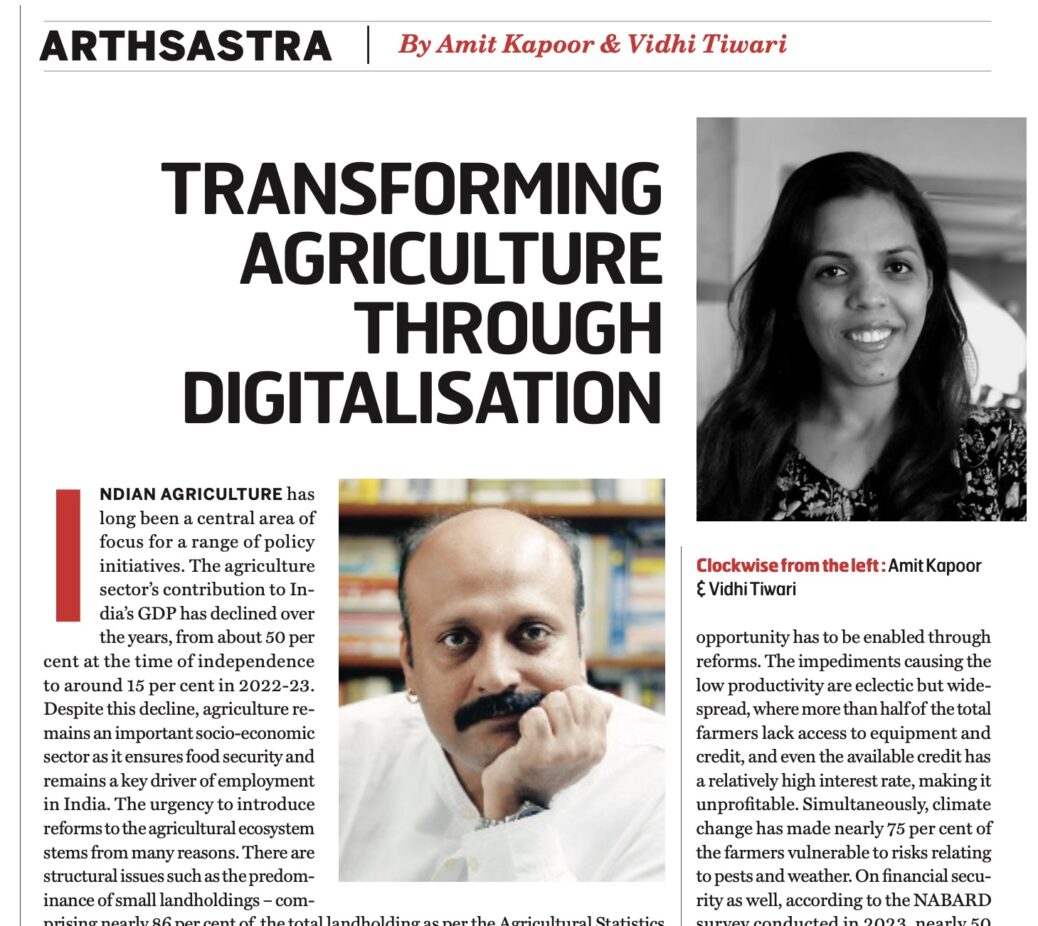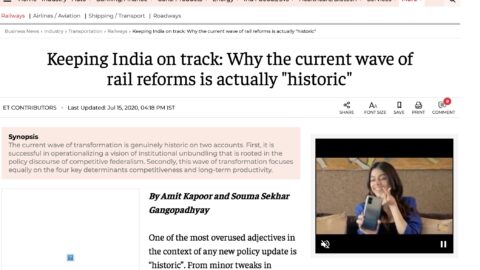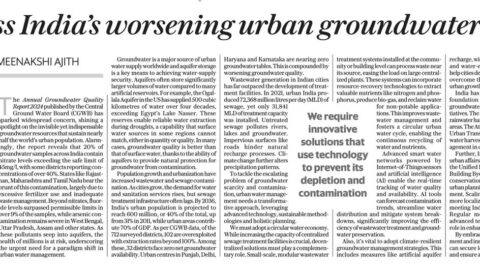By Amit Kapoor and Vidhi Tiwari
Indian agriculture has long been a central area of focus for a range of policy initiatives. The agriculture sector’s contribution to India’s GDP has declined over the years, from about 50 per cent at the time of independence to around 15 per cent in 2022-23. Despite this decline, agriculture remains an important socio-economic sector as it ensures food security and remains a key driver of employment in India. The urgency to introduce reforms to the agricultural ecosystem stems from many reasons. There are structural issues such as the predominance of small landholdings – comprising nearly 86 per cent of the total landholding as per the Agricultural Statistics released in 2022, seasonal unemployment, skill gaps, and adapting to climate change. The sector poses a conundrum: Although agriculture provides livelihood to more than 42% of the population, it contributes a little over 18 % to the GDP. Over the years, India has attempted to resolve this challenge utilising different means.
Digitalisation is rapidly gaining momentum, with various sectors exploring better integration strategies; agriculture is no exception. Reforming agriculture with digitalisation has received significant emphasis, as seen in the Economic Survey and the Budget this year. So far, the Indian experience has generated positive outcomes in deploying digital solutions and has led to the emergence of the Digital Public Infrastructure approach. For instance, incorporating DPI has led to a total savings of 33 billion dollars by 2022, equivalent to 1.14 per cent of the GDP. This goes to show DPI’s potential to elevate agriculture from an underperforming economic activity to a sustainable ecosystem with considerable productivity and incentives.
To harness digital solutions in agriculture, we must assess the sector’s landscape and get a grip on its persistent challenges. Indian agriculture’s self-sufficiency hinges on its ability to reinvent, as the new challenges of food security, climate change, and vulnerability of farmers await systematic addressal. While this sector has the potential to add nearly 600 billion dollars by 2030 to the GDP, at present, harnessing this opportunity has to be enabled through reforms. The impediments causing the low productivity are eclectic but widespread, where more than half of the total farmers lack access to equipment and credit, and even the available credit has a relatively high interest rate, making it unprofitable. Simultaneously, climate change has made nearly 75 per cent of the farmers vulnerable to risks relating to pests and weather. On financial security as well, according to the NABARD survey conducted in 2023, nearly 50 per cent of the Indian households involved in agriculture are indebted, with the rural percentage being higher. Food wastage also remains high, nearing 80 million tons during 2020-21. It is these challenges that digital solutions must address in a targeted manner.
The consultation paper on the India Digital Ecosystem of Agriculture (IDEA) in 2021 proposed a detailed vision for the systematic digitalisation of agriculture in India. The IDEA paper presented a broad blueprint for AgriStack with Agri Data Exchange (ADEx) as a component, which has since been deployed on a pilot basis in Telangana. ADEx is a necessary catalyst for harnessing the usage of large-scale data by streamlining the present datasets and subsequently presenting scalable solutions. Optimising such datasets could transform the manner in which services related to credit, insurance, pricing pointing, and relevant forecasting are offered in the agricultural sector, with the potential to reach the remotest and most underdeveloped areas with efficient and modular solutions.
The relevance of digital tools for application in agriculture is well-established in many regions. As per Farmers’ Global Insights Survey, the European framers are leading, with 55 per cent of farmers using digital tools to enhance productivity and practice precision farming, with Canada closely following at 50 per cent. Japan has harnessed robotics and drone technology for precision farming. Asia is at the lowest rank in adopting Agtech products at a meagre 9 per cent. The situation becomes particularly stark for India as the inequality in access to the internet remains low in rural areas where agriculture is practised at a larger scale.
India needs to accelerate its efforts to reform the agricultural sector with technological innovations as the core component while maintaining steady productivity and surplus, opting for sustainable practices, maintaining food security, and eliminating the vulnerabilities of the farmers, particularly small and marginal farmers. A delay in action now could lead to significant setbacks, for instance, the World Bank assesses a loss of 5 per cent of GDP by 2030 of India on account of the failure to adjust to climate change alone.
Digitalisation can provide the much-needed impetus to this ambitious goal as its scalability and modularity offer scope for innovation and tailor-made solutions. Taking note of urgency, the budget has announced a substantial investment in the digitalisation of land records across 400 districts and the creation of a database of 6 million farmers. It is important to craft AgriStack with farmers and enhance consideration of the specific needs of different sections of farmers. The incorporation of data autonomy, accountability and transparency by design should form the foundation of the AgriStack. This can also be an excellent opportunity to steer the development through cooperative federalism, enabling states to take up meaningful leadership roles in the process. The modular nature of DPI offers ample room for innovation, especially within the Public-Private Partnership model, to prioritize public interest in the ecosystem and to keep the risks of corporate monopolies at bay. Digital solutions have to be built parallel to the drive to increase access to the internet from the current 52 per cent and the scale of digital literacy with a focus on innovation-driven AgTech.
India has always been a facilitative democracy, and hence, taking economic justice to farmers by using technological advancements becomes a strategic tool to build a sustainable life with dignity.
The article was published with Business World.
























